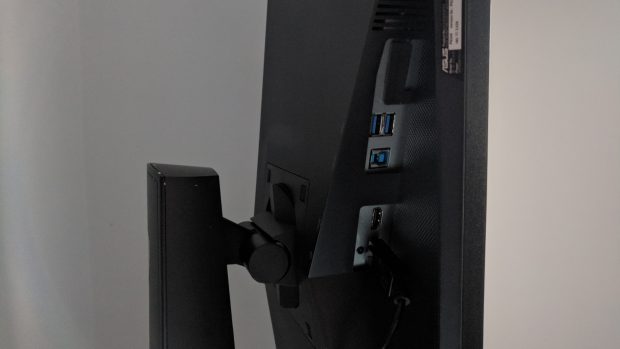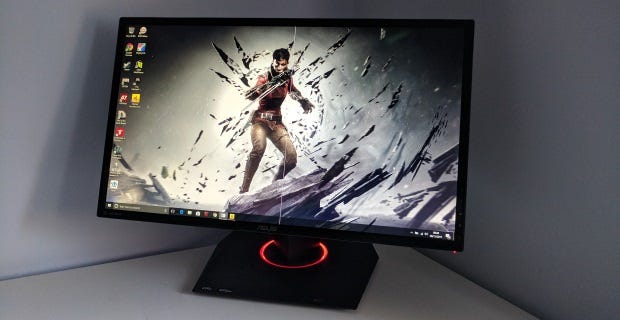Asus ROG Swift PG248Q review: A 180Hz miracle monitor?
Everything and the kitchen G-Sync
Buying a monitor used to be a fairly simple affair. You’d pick one black rectangle from the dozens of other black rectangles, and if you really pushed the boat out you might get one with an adjustable stand, or, heaven forbid, a rotating screen. These days, there’s a lot more going on. You can still opt for the faithful black rectangle, but if you’re the type of person who likes rainbow-coloured keyboards, mice and motherboards, you can now get a monitor to match.
Take Asus’ ROG Swift PG248Q. This 24in display has a glowing red ring round the base of the stand, as if the resulting monitor has arrived from another dimension inside its slate-like base. Thankfully, it can be turned off via the surprisingly easy-to-use menu buttons on the rear of the screen, but at least the option’s there if you happen to like that sort of thing.
Of course, there’s a lot more to the PG248Q than some fancy LEDs, the main one being that this Full HD (1920x1080) screen has a much higher refresh rate than normal. Whereas most monitors max out at 60Hz, or 60fps in games, the PG248Q can go all the way up to 144Hz (144fps), allowing for buttery smooth gameplay provided you’ve got a graphics card that can make the most of it. It also has Nvidia G-Sync support. This won’t be any use to AMD owners, but those with compatible Nvidia cards can use it to help eliminate screen-tearing and pull up the frame rate when numbers start to take a bit of a tumble.
If all that wasn’t enough, it’s also highly flexible, with a generous amount of tilt, swivel, rotation and height adjustment all built in. Plus, you get a pair of USB3 ports for your mouse and keyboard and a headphone jack. Asus hopes its relatively thin bezels (the black frame around the outside of the screen) will make it a good candidate for multi-screen gaming as well, but for now we’ll focus on how it stacks up as a regular single screen.

Getting back to that refresh rate, this essentially lets you break that all-important 60fps barrier and more than double the number of frames appearing onscreen - handy if you find your current graphics card is completely maxed out on all your favourite games. The catch is that you have to use the monitor’s DisplayPort connection to use it, as the HDMI port is limited to regular old 60Hz. As a result, you’ll need to check your graphics card has the right port before deciding to buy.
Provided you’ve got the right card, though, the PG248Q lets you enjoy frame rates up to 144fps. You can actually boost that number all the way up to 180fps if you enable the so-called ‘overclocking’ feature in the onboard menu, but this is really a bit of a cheat, as Asus is simply using additional software to achieve this kind of smoothness rather than the screen actually displaying that number of frames. In practice, though, it’s highly convincing, and I’d be none the wiser if I didn’t know it wasn’t a proper 180Hz display.
Indeed, if wielding Doom’s super shotgun wasn’t already one of gaming’s greatest pleasures, watching demons just melt into a sticky pile of limbs under its barrel certainly is. Likewise, leaping around Middle-earth in Shadow of War made Talion feel as if he should be in a Team Ninja game, and hunting down prey in Rise of the Tomb Raider almost felt like I'd entered a state of zen tranquility as I tracked my target across the screen.

Of course, all this is pretty meaningless if the colours are wonkier than a revenant's flight path. Fortunately, the PG248Q acquits itself well in this department, offering plenty of brightness and contrast to help pick out that fine detail. It’s not the most colour accurate screen out there, but compared to other monitors I've seen with this type of panel, it's certainly more balanced than most.
Annoyingly, it doesn’t remember any adjustments you make when alternating between its six pre-set colour profiles, resulting in a lot of unnecessary fiddling when you switch modes. Cinema was by far the most accurate one of the lot, so I’d stick with that if you want to keep things simple. If you suffer from eye strain, you’ll also appreciate Asus’ various ultra-low blue light options. This will have a natural knock-on effect on the monitor’s colour accuracy, but your eyes will thank you for it after a late-night Destiny 2 raid.

Admittedly, I could do without the Nvidia 3D Vision support and rather hideous crosshair and timer overlays that come as part of the PG248Q’s ‘GamePlus’ package, but put that aside and you’re still left with a highly capable gaming monitor. The only hurdle is the fact it costs £399 / $399. I’d prefer a slightly more colour accurate monitor for that kind of money, especially if you’re going to be using it for any kind of video work or photo editing. Indeed, the successor to my trusty AOC Q2770PQU, the Q2775PQU, currently goes for £359, and that buys you a 27in screen with near picture-perfect image quality and a 2560x1440 resolution. It doesn't have a high refresh rate or G-Sync support, but in terms of overall image quality, I'd say it's a better overall buy.
There are also cheaper 24in 144Hz monitors out there, too, such as Acer's Predator XB240H, which costs £215. I can't vouch for its image quality, but it goes to show how much of a premium you're paying for that extra G-Sync support. Sadly, you're looking at paying at least £350 for a G-Sync-enabled monitor, such as AOC's G2460PG, so in that sense the PG248Q's price isn't too out of the ordinary. Personally, the extra 36Hz and additional HDMI port you get with Asus' PG248Q over that AOC is probably worth the extra money, especially since its AMD FreeSync cousin, the AOC G2460PF, is currently our best gaming monitor of choice in the 24in category.









